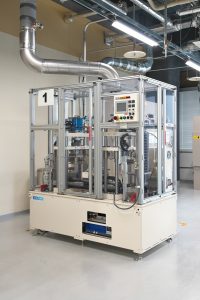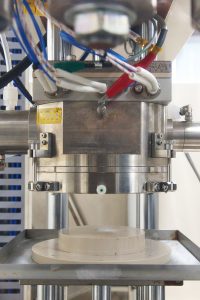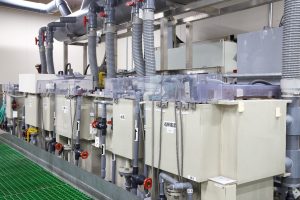Toyota Develops Environmentally Efficient Plating Technology
Toyota Motor Corporation (Toyota) has developed new plating technology that reduces the environmental impact of the process, used in the manufacture of electronic parts.
In the new system, metal ions pass through a polymer membrane (solid electrolyte membrane) to apply plating like a stamp, exclusively to those areas which require plating. The technology is used in the plating process for forming copper, nickel, and other metal coatings on substrates.
Toyota is working with Mikado Technos and Kanematsu Corporation to manufacture and sell new plating machines based on this new technology, to encourage its uptake. The machines are available from this week (1 July)
Improved process
The new stamping-type plating machine eliminates the dipping process currently required in the most common plating techniques, where parts have to be immersed in multiple baths of plating solution. This dramatically reduces the waste solution to about one-thirtieth and CO2 emissions to about one-third of previous levels. As well as this significant reduction in environmental impact. the technology also reduces plating time.
The new stamping-type plating machine has a head section in which the upper part is filled with solution. A solid electrolyte membrane through which the metal ions pass is mounted on the tip of the head, which is then pressed against the area to be plated. This structure allows the membrane to be applied only to that part of the substrate that requires plating. When an electric current is activated, a metal film (plating) is applied like a stamp to the area in contact with the membrane.
In the conventional plating process, substrates are completely immersed in solutions of copper, nickel or other plating metal. This requires multiple large baths for dipping the complete substrates, and substrate washing processes before and after plating. Large amounts of plating solution have to be used, because the complete substrates have to be immersed, creating waste. The extensive process also requires equipment for removing toxic substances released into the air and treating the waste solution.
The environmental benefits helped prompt Toyota to launch the new stamping-type plating machine and expand its use beyond its automotive manufacturing partners to many other companies in a range of industries. Specifically, Toyota is supporting vacuum press manufacturer Mikado Technos with patents and expertise. This company has incorporated its own technologies to develop and manufacture a stamping-type plating machine for sale through Kanematsu.
Over the next two to three years, Toyota hopes to market the new equipment for use as a test machine for verification and evaluation purposes. Beyond that time, it will expand its sales to encourage its more widespread use as a full production machine.
The Plant Zero CO2 Emissions Challenge is part of the Toyota Environmental Challenge 2050, an initiative to contribute to the creation of a sustainable society. This is one of the United Nations’ SDG international goals*2. The Toyota Group will work together to fulfil this challenge, adopting stamped plating machines within its businesses and steadily reducing the amount of CO2 it emits during its production processes.
Ends
| *1 | As of end of May 2020 (Toyota research) |
| *2 | The International Goals to 2030, adopted by the United Nations General Assembly in September 2015. It is a comprehensive set of 17 goals (social issues) for achieving a sustainable society. |






